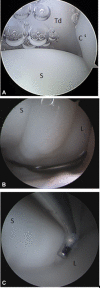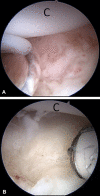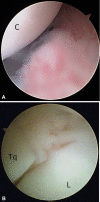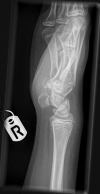Arthroscopic Capsular Shrinkage Is Safe and Effective in the Treatment of Midcarpal Instability in a Pediatric Population: A Single-Center Experience of 51 Cases
- PMID: 37223383
- PMCID: PMC10202579
- DOI: 10.1055/s-0042-1750871
Arthroscopic Capsular Shrinkage Is Safe and Effective in the Treatment of Midcarpal Instability in a Pediatric Population: A Single-Center Experience of 51 Cases
Abstract
Objective Treatment of palmar midcarpal instability (PMCI) remains controversial and children can develop PMCI from asymptomatic hypermobility. Recently, case series have been published regarding the use of arthroscopic thermal shrinkage of the capsule in adults. Reports of the use of the technique in children and adolescents are rare, and there are no published case series. Methods In a tertiary hand center for children's hand and wrist conditions, 51 patients were treated with arthroscopy for PMCI between 2014 and 2021. Eighteen out of 51 patients carried additional diagnosis of juvenile idiopathic arthritis (JIA) or a congenital arthritis. Data were collected including range of movement, visual analog scale (VAS) at rest and with load, and grip strength. Data were used to determine the safety and efficacy of this treatment in pediatric and adolescent patients. Results Mean follow-up was 11.9 months. The procedure was well tolerated and no complications were recorded. Range of movement was preserved postoperatively. In all groups VAS scores at rest and with load improved. Those who underwent arthroscopic capsular shrinkage (ACS) had significantly greater improvement in VAS with load, compared with those who underwent arthroscopic synovectomy alone ( p = 0.04). Comparing those treated with underlying JIA versus those without, there was no difference in postoperative range of movement, but there was significantly greater improvement for the non-JIA group in terms of both VAS at rest ( p = 0.02) and VAS with load ( p = 0.02). Those with JIA and hypermobility stabilized postoperatively, and those with JIA with signs of early carpal collapse and no hypermobility achieved improved range of movement, in terms of flexion ( p = 0.02), extension ( p = 0.03), and radial deviation ( p = 0.01). Conclusion ACS is a well-tolerated, safe, and effective procedure for PMCI in children and adolescents. It improves pain and instability at rest and with load, and offers benefit over open synovectomy alone. This is the first case series describing the usefulness of the procedure in children and adolescents, and demonstrates effective use of the technique in experienced hands in a specialist center. Level of Evidence This is a Level IV study.
Keywords: adolescence; arthroscopy; capsular shrinkage; juvenile idiopathic arthritis; midcarpal instability; synovectomy.
Thieme. All rights reserved.
Conflict of interest statement
Conflict of Interest None declared.
Figures





Similar articles
-
Long-Term Results of Arthroscopic Capsular Shrinkage for Palmar Midcarpal Instability of the Wrist.J Wrist Surg. 2021 Jun;10(3):224-228. doi: 10.1055/s-0040-1722331. Epub 2021 Feb 4. J Wrist Surg. 2021. PMID: 34109065 Free PMC article.
-
Palmer Midcarpal Instability: An Algorithm of Diagnosis and Surgical Management.J Wrist Surg. 2017 Nov;6(4):262-275. doi: 10.1055/s-0037-1606379. Epub 2017 Aug 30. J Wrist Surg. 2017. PMID: 29085727 Free PMC article.
-
Arthroscopic thermal capsular shrinkage for palmar midcarpal instability.J Wrist Surg. 2014 Aug;3(3):162-5. doi: 10.1055/s-0034-1384838. J Wrist Surg. 2014. PMID: 25097808 Free PMC article.
-
Midcarpal Instability: The Role of Wrist Arthroscopy.Hand Clin. 2017 Nov;33(4):717-726. doi: 10.1016/j.hcl.2017.06.003. Hand Clin. 2017. PMID: 28991583 Review.
-
Midcarpal instability.J Hand Surg Eur Vol. 2016 Jan;41(1):86-93. doi: 10.1177/1753193415617756. Epub 2015 Nov 22. J Hand Surg Eur Vol. 2016. PMID: 26598109 Review.
References
-
- Mouchet A, Belot J. Poignet à ressaut: subluxation mediocarpienne en avant. Bull Mem la Soc Natl Chir. 1934;60:1243–1244.
-
- Lichtman D, Bruckner J, Culp R, Alexander C E. Palmar midcarpal instability: results of surgical reconstruction. J Hand Surg Am. 1981;6(06):515–523. - PubMed
-
- Lichtman D M, Bruckner J D, Culp R W, Alexander C E. Palmar midcarpal instability: results of surgical reconstruction. J Hand Surg Am. 1993;18(02):307–315. - PubMed

